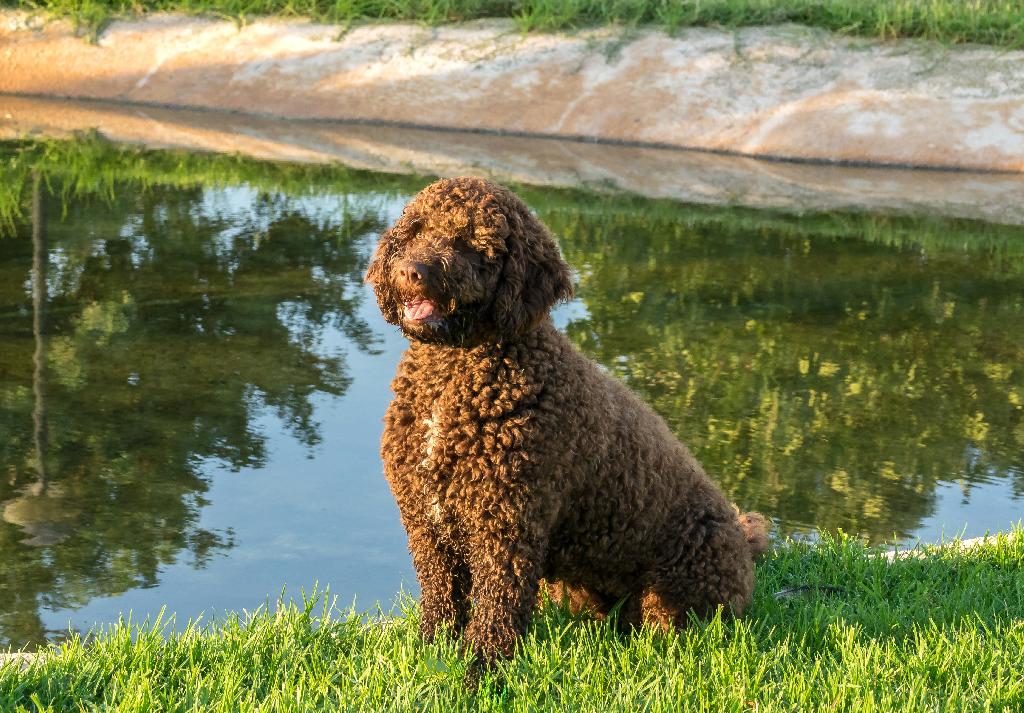Spanish Water Dog

Description
The Spanish Water Dog, known as *Perro de Agua Español* in its native Spain, is a versatile and highly skilled working dog with a rich history. Originally bred in Spain for various tasks, including herding, hunting, and water retrieving, the breed is highly regarded for its intelligence, agility, and strong work ethic. The Spanish Water Dog's history dates back to at least the 12th century, where it was used by fishermen along the coast to retrieve fish and nets from the water. Over time, this breed also became highly valued by shepherds for herding sheep and goats, as well as for its ability to guard livestock. Today, the breed is still widely used for herding, water work, and as a companion dog in Spain and around the world.
Physically, the Spanish Water Dog is a medium-sized dog, standing between 17 and 20 inches at the shoulder and weighing between 30 and 50 pounds. It has a compact and muscular build, well-suited to its working roles. The breed is most recognizable by its curly, woolly coat, which is water-resistant and often forms cords, similar to the coat of a poodle. This coat provides protection against the elements, particularly when working in water or in harsh weather conditions. The coat comes in a variety of colors, including white, black, brown, and a combination of these colors, often with patchy markings. Their expressive, dark eyes and ears that hang close to the head contribute to their alert and intelligent appearance.
Temperamentally, the Spanish Water Dog is known for being highly intelligent, loyal, and energetic. It thrives on mental and physical challenges, making it an excellent working dog for herding and water retrieval tasks. The breed is eager to please, which makes it highly trainable, although it can be somewhat independent and may require an experienced handler to fully harness its potential. Spanish Water Dogs are often described as friendly and affectionate, forming strong bonds with their families. They tend to be good with children and other pets, although their high energy and herding instincts may cause them to be a bit boisterous or overly enthusiastic at times.
The Spanish Water Dog requires regular exercise and stimulation to stay happy and healthy. It excels in active households where it can be given a job to do, such as herding, retrieving, or participating in dog sports like agility or obedience. The breed is also an excellent swimming companion, thanks to its natural affinity for water, and it enjoys activities that allow it to use its swimming and retrieving skills. Grooming the Spanish Water Dog requires regular maintenance to keep the coat in good condition, including brushing and occasional washing to prevent matting of the cords. Because of its intelligence and versatility, the Spanish Water Dog makes an exceptional working dog as well as a loving, active companion. Its natural instincts, combined with its affectionate nature, make it a well-rounded and adaptable breed suitable for various tasks and living situations.
History
The Spanish Water Dog (*Perro de Agua Español*) is a versatile and ancient breed with a long history as a working dog in Spain. Its origins are believed to date back over a thousand years, with its ancestors thought to have arrived in the Iberian Peninsula with traders from North Africa or the Middle East. These early water dogs were prized for their adaptability, intelligence, and versatility, making them ideal for a range of tasks, including herding livestock, retrieving from water, and assisting fishermen. The breed became particularly associated with rural and coastal regions of Spain, such as Andalusia, where it excelled as both a herder and water retriever.
Throughout the centuries, the Spanish Water Dog remained a staple of working life in Spain, valued for its ability to adapt to the diverse needs of its owners. Its curly, waterproof coat provided protection from harsh weather and dense vegetation, making it well-suited for both land and water tasks. The breed’s intelligence and trainability allowed it to excel in herding sheep and goats, retrieving fish and nets for fishermen, and even guarding property.
Despite its long history, the Spanish Water Dog was relatively unknown outside its working communities until the mid-20th century. As rural lifestyles changed and mechanization replaced many traditional roles, the breed’s numbers began to decline. However, dedicated Spanish breeders and enthusiasts worked to preserve the *Perro de Agua Español*, emphasizing its historical significance and unique characteristics. In 1985, the Spanish Water Dog was officially recognized by the Spanish Royal Canine Society, and its popularity began to grow.
Today, the Spanish Water Dog is celebrated not only for its working abilities but also as a loyal and affectionate companion. It has gained recognition in international dog communities, including the American Kennel Club (AKC) in 2015. The breed’s rich history and enduring versatility highlight its importance in Spain’s agricultural and maritime heritage, as well as its modern role as a cherished family pet and competitive sport dog.
Colors
• Beige
• Beige & White w/Black Nose
• Beige & White w/Brown Nose
• Beige w/Black Nose
• Beige w/Brown Nose
• Black
• Black & White
• Brown
• Brown & White
• White & Black
• White & Brown
• White w/Black and Tan
• White w/Black Nose
• White w/Brown Nose
• White w/Brown Tick


